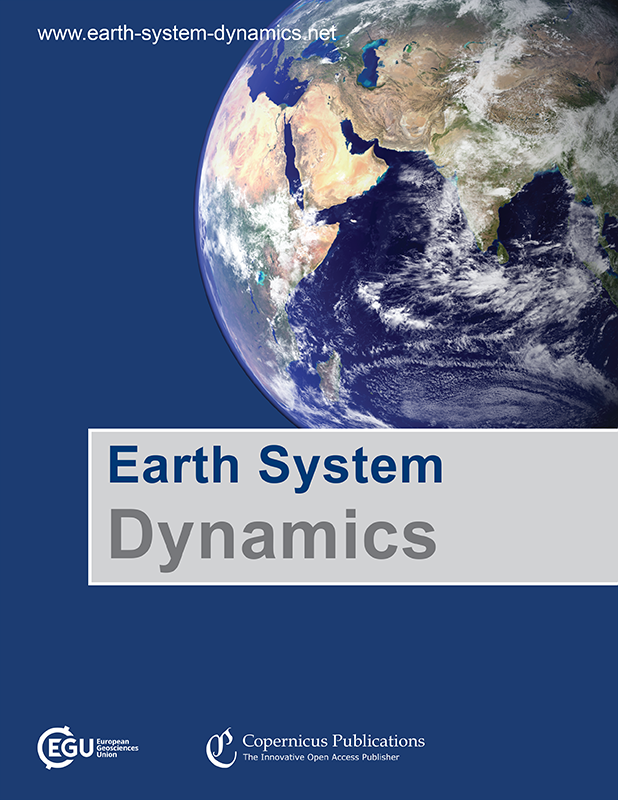Land cover and management effects on ecosystem resistance to drought stress
IF 7.2
2区 地球科学
Q1 GEOSCIENCES, MULTIDISCIPLINARY
引用次数: 0
Abstract
Abstract. Drought events are projected to become more severe and frequent across many regions in the future, but their impacts will likely differ among ecosystems depending on their ability to maintain functioning during droughts, i.e., ecosystem resistance. Plant species have diverse strategies to cope with drought. As a result, divergent responses of different vegetation types for similar levels of drought severity have been observed. It remains unclear whether such divergence can be explained by different drought duration; co-occurring compounding effects, e.g., heat stress or memory effects; management practices; etc. Here, we provide a global synthesis of vegetation resistance to drought and heat using different proxies for vegetation condition, namely the vegetation optical depth (L-VOD) data from the ESA Soil Moisture and Ocean Salinity (SMOS) passive L-band microwave mission and enhanced vegetation index (EVI) and kernel normalized difference vegetation index (kNDVI) from NASA MODIS. Due to its longer wavelength, L-VOD has the advantage over more commonly used vegetation indices (such as kNDVI, EVI) in that it provides different information on vegetation structure and biomass and suffers from less saturation over dense forests. We apply a linear model accounting for drought and temperature effects to characterize ecosystem resistance by their sensitivity to drought duration and temperature anomalies. We analyze how ecosystem resistance varies with land cover across the globe and investigate the potential effects of forest management and crop irrigation. We compare estimates of ecosystem resistance to drought and heat as retrieved from L-VOD, kNDVI, and EVI products. We find that regions with higher forest fraction show stronger ecosystem resistance to extreme droughts than cropland for all three vegetation proxies. L-VOD indicates that primary forests tend to be more resistant to drought events than secondary forests when controlling for the differences in background climate, but this cannot be detected in EVI and kNDVI. The difference is possibly related to EVI and kNDVI saturation in dense forests. In tropical primary evergreen broadleaf forests, old-growth trees tend to be more resistant to drought than young trees from L-VOD and kNDVI. Irrigation increases the drought resistance of cropland substantially. Forest harvest decreases the drought resistance of forests. Our results suggest that ecosystem resistance can be better monitored using L-VOD in dense forests and highlight the role of forest cover, forest management, and irrigation in determining ecosystem resistance to droughts.土地覆盖和管理对生态系统抗旱能力的影响
摘要预计未来许多地区的干旱事件将变得更加严重和频繁,但其影响可能因生态系统在干旱期间维持功能的能力(即生态系统抵抗力)而有所不同。植物物种应对干旱的策略多种多样。因此,人们观察到不同植被类型对类似严重干旱程度的不同反应。目前还不清楚这种差异是否可以用不同的干旱持续时间、同时出现的复合效应(如热胁迫或记忆效应)、管理方法等来解释。在此,我们利用不同的植被状况代用指标,即来自欧空局土壤水分和海洋盐度(SMOS)被动 L 波段微波任务的植被光学深度(L-VOD)数据,以及来自美国宇航局 MODIS 的增强植被指数(EVI)和核归一化差异植被指数(kNDVI),对植被的抗旱和抗热能力进行了全球综合分析。由于波长较长,L-VOD 与更常用的植被指数(如 kNDVI、EVI)相比具有优势,它能提供不同的植被结构和生物量信息,并且在密林中的饱和度较低。我们采用一个考虑干旱和温度影响的线性模型,通过生态系统对干旱持续时间和温度异常的敏感性来描述生态系统抗性。我们分析了生态系统抵抗力如何随全球土地覆盖而变化,并研究了森林管理和作物灌溉的潜在影响。我们比较了从 L-VOD、kNDVI 和 EVI 产品中获取的生态系统对干旱和高温的抵抗力估计值。我们发现,就所有三种植被代用指标而言,森林覆盖率较高的地区比耕地对极端干旱的生态系统抵抗力更强。L-VOD 表明,在控制背景气候差异的情况下,原始森林往往比次生林更能抵御干旱事件,但 EVI 和 kNDVI 无法检测到这一点。这种差异可能与密林中的 EVI 和 kNDVI 饱和度有关。在热带原始常绿阔叶林中,从 L-VOD 和 kNDVI 来看,老树往往比幼树更抗旱。灌溉可大幅提高耕地的抗旱性。森林采伐降低了森林的抗旱性。我们的研究结果表明,在密林中使用 L-VOD 可以更好地监测生态系统的抗旱性,并强调了森林覆盖率、森林管理和灌溉在决定生态系统抗旱性中的作用。
本文章由计算机程序翻译,如有差异,请以英文原文为准。
求助全文
约1分钟内获得全文
求助全文
来源期刊

Earth System Dynamics
GEOSCIENCES, MULTIDISCIPLINARY-
CiteScore
13.20
自引率
5.50%
发文量
61
审稿时长
36 weeks
期刊介绍:
Earth System Dynamics (ESD) is a not-for-profit international scientific journal committed to publishing and facilitating public discussion on interdisciplinary studies focusing on the Earth system and global change. The journal explores the intricate interactions among Earth's component systems, including the atmosphere, cryosphere, hydrosphere, oceans, pedosphere, lithosphere, and the influence of life and human activity. ESD welcomes contributions that delve into these interactions, their conceptualization, modeling, quantification, predictions of global change impacts, and their implications for Earth's habitability, humanity, and the future dynamics in the Anthropocene.
 求助内容:
求助内容: 应助结果提醒方式:
应助结果提醒方式:


